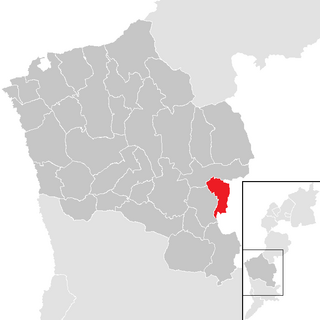
Mattersburg is a town in Burgenland, Austria. It is the administrative center of the District of Mattersburg and was home to former Bundesliga football team, SV Mattersburg.

Güssing is a town in Burgenland, Austria. It is located at 47°4′N16°19′E, with a population of 3,610 (2023), and is the administrative center of the Güssing district. For centuries the town occupied an important position on the western edge of the Kingdom of Hungary. The town is now most famous for its castle, which is the oldest in Burgenland and a prominent regional landmark, built on an extinct volcano.

Oberpullendorf is a town in Burgenland, Austria. It is the administrative center of the district of Oberpullendorf.

Pinkafeld is a city in Burgenland in Austria and the second largest settlement in the district Oberwart.

Bad Tatzmannsdorf is a municipality in Burgenland in the district of Oberwart in Austria.

Kittsee is an Austrian municipality in the District of Neusiedl am See, Burgenland.
Heinrich Thyssen, after 22 June 1907 Heinrich, Baron Thyssen-Bornemisza de Kászon et Impérfalva, was a Hungarian-German entrepreneur and art collector.

Frauenkirchen is an Austrian town in the district of Neusiedl am See, Burgenland.

Lackenbach is an Austrian municipality in the District of Oberpullendorf, Burgenland.

Donnerskirchen is a market town in the district Eisenstadt-Umgebung in the Austrian state of Burgenland.

The House of Batthyány is an ancient and distinguished Hungarian noble magnate family. The Head of the family bears the title Prince (Fürst) of Batthyány-Strattmann, while other members of this family bear the title Count/Countess (Graf/Gräfin) Batthyány von Német-Ujvar respectively. A branch of the family was notable in Bosnia and Croatia as well, producing several Bans (viceroys) of Jajce in the 15th and 16th century and later Bans of Croatia in the 16th, 17th and 18th century.

Heiligenbrunn is a town in the district of Güssing in the Austrian state of Burgenland. It is known for being a centre of the Uhudler wine and for its historic Kellerviertel, or wine cellar quarter, where the wine was made.

Königsdorf is a village in the district of Jennersdorf in the Austrian state of Burgenland. In 2022 the population of the village was 768.

Potzneusiedl is the smallest village in the district of Neusiedl am See in Burgenland in Austria.

Lockenhaus is a town in the district of Oberpullendorf in the Austrian state of Burgenland. The town is well known for the annual Lockenhaus Chamber Music Festival founded by violinist Gidon Kremer.

Schandorf is a village in the district of Oberwart in Burgenland in southeastern Austria.

Weiden bei Rechnitz is a town in the district of Oberwart in the Austrian state of Burgenland.
The Deutsch Schützen massacre was a 1945 mass killing of approximately 60 Jewish forced laborers by the Waffen-SS in Deutsch Schützen-Eisenberg in Austria. At the old church, Martinskirche, in the farmland on the west side of Deutsch Schützen, a plaque is erected on the exterior of the building memorializing those murdered in the massacre.

Franz Podezin (1911–1995) was a German SS-Hauptscharführer and Gestapo chief in Rechnitz, Austria. On the night of 24–25 March 1945, allegedly on the direction of the "Killer Countess", Margaret of Batthyany daughter of Baron Heinrich Thyssen, Podezin engaged in the massacre of at least 180 Hungarian Jewish slave laborers in Rechnitz who were assigned to dig anti-tank ditches in anticipation of the approaching Red Army.

Schloss Rechnitz also known as Schloss Batthyány, was a castle located in the center of Rechnitz in the Oberwart district of Burgenland, Austria. It belonged to the Batthyány family for several centuries. It was largely destroyed during World War II in 1945. Today, only a few remnants of the castle remain.






















